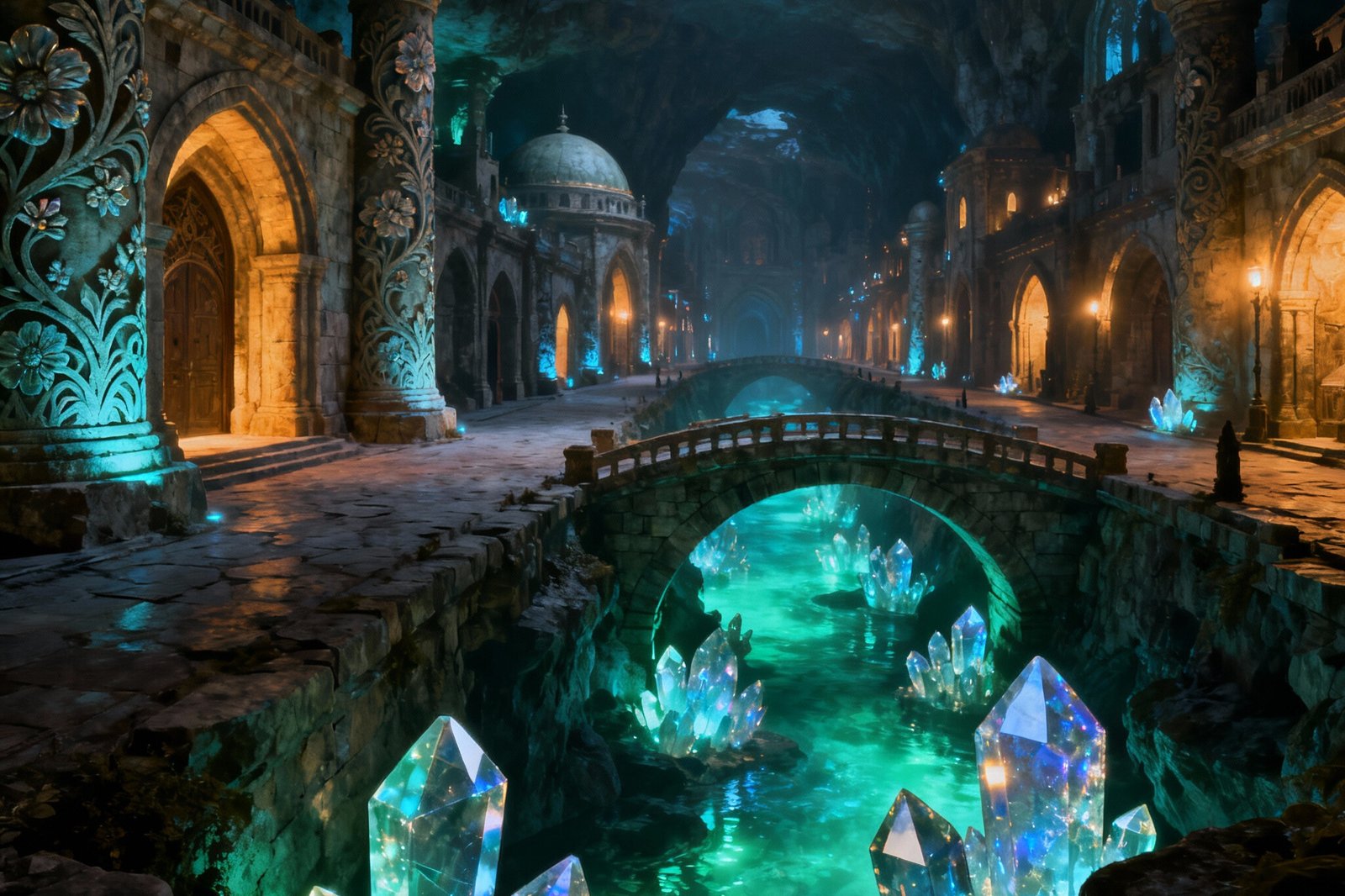Fantasy medieval underground settings have captivated readers, gamers, and storytellers for generations, offering mysterious depths where entire civilizations thrive beneath the earth’s surface. These subterranean worlds extend far beyond simple dungeon crawls, encompassing complex societies, intricate trade networks, and unique cultures adapted to life without sunlight. Understanding fantasy medieval underground environments opens doors to rich storytelling possibilities and immersive worldbuilding experiences.
What Makes Fantasy Medieval Underground Settings So Compelling?
The allure of fantasy medieval underground realms lies in their stark contrast to surface world conventions. While medieval surface societies relied on agriculture, seasonal cycles, and celestial navigation, underground civilizations developed entirely different survival mechanisms and cultural practices.
These subterranean environments challenge traditional fantasy tropes by creating societies where darkness becomes home, stone replaces wood as the primary building material, and navigation depends on geological landmarks rather than stars or horizons. The confined spaces and unique resource availability forge communities with distinct social structures, economic systems, and technological innovations.
Historical Context: Real Medieval Dungeons vs Fantasy Portrayals
Medieval dungeons in historical reality differed significantly from their fantasy counterparts. The term “dungeon” originally referred to the “donjon” or central keep of castles, not underground prison complexes. True medieval castle underground areas typically included:
-
Cellars for food storage and preservation
-
Drainage systems for waste management
-
Workshops for craftsmen and artisans
-
Simple walled rooms accessible through single doors or trapdoors
Fantasy literature transformed these practical spaces into elaborate labyrinthine networks, creating the underground adventure settings we recognize today. This evolution from functional castle basements to mysterious subterranean worlds reflects our fascination with hidden realms and unknown depths.
Building Believable Underground Civilizations
Essential Infrastructure for Subterranean Societies
Creating realistic fantasy medieval underground communities requires careful consideration of basic survival needs that surface dwellers take for granted. Successful underground civilizations must address several critical infrastructure challenges:
Ventilation Systems
Underground communities need sophisticated air circulation to prevent suffocation and maintain breathable atmosphere. Fantasy settings often incorporate magical solutions, but practical approaches include natural air shafts, wind-powered ventilation systems, and strategic tunnel positioning to create airflow.
Light Sources and Energy
Without sunlight, underground societies depend entirely on artificial illumination. Medieval technology limited options to torches, candles, and oil lamps, though fantasy settings can incorporate magical light sources, bioluminescent organisms, or complex mirror systems reflecting surface light into deep caverns.
Water Management
Access to clean water sources becomes paramount in underground environments. Natural underground streams, careful collection of surface runoff through hidden channels, and sophisticated storage systems ensure community survival.
Social Structure and Class Systems
Underground societies often develop unique social hierarchies based on their environmental constraints and resource availability. Common social structures include:
-
Mining Guilds: Controlling access to precious metals and gems
-
Light Keepers: Maintaining illumination throughout the community
-
Surface Traders: Managing relationships with above-ground civilizations
-
Tunnel Engineers: Designing and maintaining passage networks
These specialized roles create interdependent communities where individual skills directly impact collective survival, often resulting in more egalitarian societies than their surface counterparts.
Navigation and Geography in Fantasy Underground Realms
The Art of Subterranean Wayfinding
Navigation in fantasy medieval underground settings requires entirely different landmark systems than surface travel. Without horizons, sun positions, or star constellations, underground travelers develop sophisticated wayfinding techniques:
Geological Landmarks
Underground navigation relies heavily on natural formations like stalactites and stalagmites, which serve as vital signposts developed over centuries through mineral deposits. These formations create unique “fingerprints” for specific locations, allowing experienced underground travelers to navigate vast cave systems.
Route Memory and Oral Traditions
Knowledge of safe passages, dangerous areas, and resource locations passes down through generations via oral traditions and carefully maintained maps. Master navigators become invaluable community members, their expertise often determining survival during emergencies or exploration expeditions.
Sound and Air Current Mapping
Experienced underground dwellers learn to interpret subtle air movements, echo patterns, and acoustic properties that indicate tunnel directions, chamber sizes, and potential hazards or exits.
Three-Dimensional Underground Networks
Fantasy medieval underground environments function as complex three-dimensional networks of interconnected chambers, tunnels, and natural formations. These systems often include:
-
Main arterial passages: Primary routes connecting major settlements
-
Secondary tunnel networks: Local passages serving specific communities
-
Natural cave systems: Unmodified underground spaces providing expansion opportunities
-
Defensive chokepoints: Strategic narrow passages easily defended against invaders
Economic Systems and Trade Networks
Underground Commerce and Resource Management
Underground economies in fantasy medieval settings typically revolve around unique resource advantages unavailable to surface civilizations. These specialized markets include:
Precious Metals and Gemstones
Underground communities often control access to valuable mining resources, creating the foundation for extensive trade networks with surface civilizations. Rare metals, precious gems, and unique mineral formations become primary export commodities.
Specialized Craftsmanship
Limited resources underground drive innovation in craftsmanship and engineering. Underground artisans often develop superior metalworking, stonework, and mechanical skills, creating highly sought-after goods.
Knowledge and Services
Underground civilizations frequently serve as neutral trading posts, information brokers, and safe passage providers for surface travelers seeking to avoid dangerous overland routes.
Trade Route Management
Many fantasy underground civilizations establish themselves as vital links in broader trade networks by offering:
-
Safe passage through dangerous terrain
-
Secure storage for valuable cargo
-
Neutral meeting grounds for competing surface factions
-
Specialized services like equipment repair and resupply
Cultural Adaptations and Lifestyle
Daily Life Without Sunlight
Fantasy medieval underground communities develop unique cultural practices adapted to their environment. These adaptations include:
Time Management
Without natural day-night cycles, underground societies create artificial time structures based on work shifts, community activities, and resource management schedules.
Architecture and Living Spaces
Underground architecture emphasizes functionality, structural integrity, and efficient use of carved space. Homes often feature multiple levels carved into rock faces, with communal areas designed around light sources and ventilation systems.
Food Production and Preservation
Underground food systems typically combine:
-
Fungus farming in specially prepared growing chambers
-
Preserved foods traded from surface communities
-
Limited livestock adapted to underground conditions
-
Hydroponic systems using reflected sunlight or magical illumination
Social Customs and Traditions
Underground societies often develop distinctive cultural practices reflecting their unique environment:
-
Sound-based communication: Complex systems of echoes and acoustic signals for long-distance messaging
-
Mineral-based art: Decorative use of naturally occurring crystals and stone formations
-
Community interdependence: Strong social bonds necessary for survival in challenging conditions
Famous Examples in Fantasy Literature and Gaming
Literary Inspirations
Several renowned fantasy works showcase exemplary underground civilizations that have influenced the genre:
Tolkien’s Middle-earth
The underground realms of Moria (Khazad-dûm) and Erebor demonstrate how dwarven civilizations adapted to subterranean life, creating vast halls, sophisticated mining operations, and defensive networks. These examples show underground societies maintaining rich cultural traditions while developing unique architectural styles.
The Underdark
Dungeons & Dragons’ Underdark presents a complete underground ecosystem with multiple civilizations, complex political relationships, and environmental challenges that have become standard references for fantasy underground worldbuilding.
Gaming Applications
Modern games have expanded underground fantasy concepts by incorporating:
-
Dynamic underground exploration mechanics
-
Complex underground city management systems
-
Multi-level subterranean combat environments
-
Underground faction politics and diplomacy
Environmental Challenges and Solutions
Overcoming Underground Obstacles
Fantasy medieval underground civilizations must address numerous environmental challenges that surface communities never encounter:
Structural Integrity
Underground construction requires careful engineering to prevent cave-ins, manage water infiltration, and maintain structural stability over time. Fantasy solutions often incorporate magical reinforcement or superior dwarven engineering techniques.
Disease and Health Management
Confined underground spaces can facilitate disease transmission and create health challenges related to limited air circulation and sunlight exposure. Successful underground communities develop specialized medical knowledge and sanitation practices.
Resource Scarcity
Limited access to surface resources drives innovation in recycling, conservation, and alternative material development. Underground societies become masters of efficiency and resource management.
Climate Control and Comfort
Underground environments typically maintain stable temperatures but may suffer from humidity, air quality, and thermal regulation issues. Fantasy underground communities address these challenges through:
-
Strategic use of geothermal energy sources
-
Sophisticated drainage and moisture control systems
-
Ventilation networks designed for optimal air circulation
-
Insulation techniques using available materials like furs and wools
Modern Applications and Inspiration
Contemporary Worldbuilding Applications
Modern fantasy creators draw inspiration from underground civilizations for various media:
-
Video Game Design: Complex underground level design and city management mechanics
-
Tabletop RPG Campaigns: Rich underground adventure settings with political intrigue
-
Fantasy Literature: Unique cultural perspectives and environmental storytelling opportunities
-
Film and Television: Visually striking underground environments and societies
The enduring popularity of fantasy medieval underground settings demonstrates their versatility for exploring themes of adaptation, community survival, and alternative social structures.
Conclusion
Fantasy medieval underground civilizations offer rich possibilities for creative storytelling and immersive worldbuilding experiences that extend far beyond traditional dungeon adventures. These subterranean societies challenge conventional medieval fantasy tropes by presenting unique environmental constraints, specialized economies, and distinctive cultural adaptations that create compelling narrative opportunities.
Whether developing underground civilizations for literature, gaming, or personal creative projects, understanding the practical challenges and creative solutions of fantasy medieval underground life provides essential foundation for believable worldbuilding. From navigation systems based on geological landmarks to complex trade networks built around precious resources, these hidden realms continue inspiring creators and audiences seeking alternatives to surface-world adventures.
The lasting appeal of fantasy medieval underground settings lies in their combination of mystery, challenge, and unlimited creative potential, making them invaluable additions to any fantasy creator’s toolkit.
FAQs
Q1: What makes fantasy medieval underground different from regular dungeons?
Fantasy medieval underground encompasses entire civilizations and complex societies, not just adventure locations. These settings feature permanent communities with their own cultures, economies, and political systems, while dungeons typically serve as temporary adventure sites or storage areas.
Q2: How do underground civilizations obtain food without agriculture?
Underground communities typically combine fungus farming, preserved food trade with surface civilizations, limited livestock adapted to cave environments, and innovative growing techniques using reflected sunlight or magical illumination for hydroponic systems.
Q3: What are the main challenges of underground living in fantasy settings?
Primary challenges include ventilation and air quality, reliable light sources, structural integrity of living spaces, water management, disease prevention in confined spaces, and maintaining trade relationships with surface communities.
Q4: How do underground societies navigate without landmarks?
Underground navigation relies on geological formations like stalactites and stalagmites as permanent landmarks, route knowledge passed through generations, sound and echo interpretation, air current mapping, and carefully maintained tunnel networks with recognizable markers.
Q5: What resources make underground civilizations valuable to surface dwellers?
Underground communities typically control precious metals, rare gemstones, specialized craftsmanship, neutral trading posts, safe passage routes, and unique knowledge about underground environments that surface civilizations cannot easily obtain elsewhere.







Leave a Reply